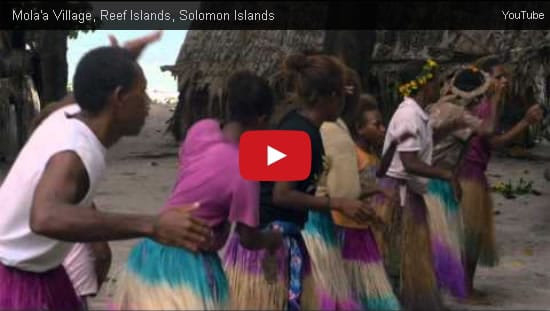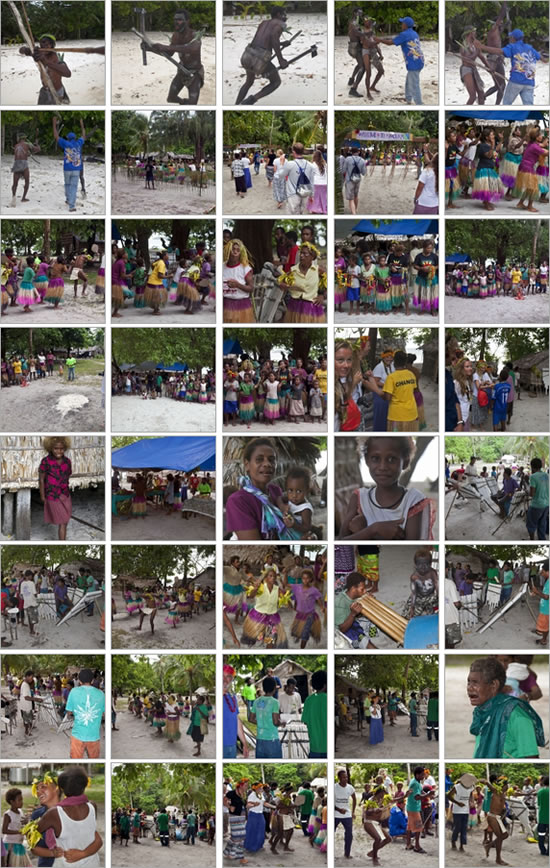Today both the education and science teams conducted business as usual; however, the afternoon brought about a special welcome ceremony that few get to experience.
In order to work in the Solomon Islands, we obtained both a national and provincial government permit. Additionally, people in the Solomon Islands have customary land ownership. Land is handed down from parents to their children. Land can only be leased, not sold. Each community also has usage rights for designated areas of the ocean, including coral reefs.
Everywhere we have been in the Solomon Islands, we have also had to get permission from each of the communities to survey their reefs. Upon arrival in the Reef Islands, the education team set out to get permission and set up education talks. John Laulae from Mola’a village joined our education team. He greeted us with a big smile and welcomed us to his village. After some conversation, he also offered to perform a customary welcome ceremony for the science and education teams.
The following day, we were all ready for the ceremony. As the boat pulled up, the sound of the Triton’s trumpet resonated throughout the village signaling our arrival. Everyone in the village took their places. We all stood on the white sandy beach waiting for the ceremony to begin.
Out of the blue, several men and boys dressed in traditional clothing ran out to the beach with bows and arrows and axes in their hands. They reenacted a historical scene where they pretended to attack us. Then Chief John ran out onto the beach with red feather money, which historically is used as a sign of peace. After the warriors saw the money, they ceased their actions accepting the feather money.
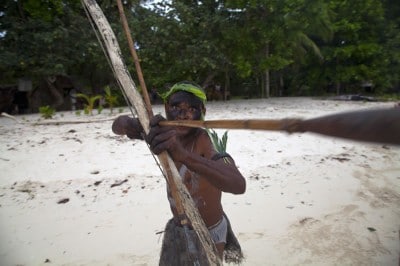
Warrior pretending the shoot Ken Marks with a bow and arrow.
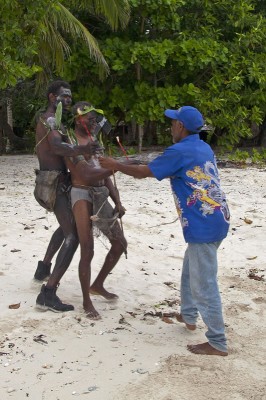
Chief John offering a sign of peace with feather money.
We were all asked to walk to the entrance of a path that was lined with wooden poles. Each pole was connected to each other by string that had palm fronds hanging from them. To everyone’s surprise, a bamboo band started playing in the distance, and the villagers started dancing through the palm frond maze, and we followed. This path brought us to the entrance of the village where the residents posted a sign that said, “Welcome to Mola’a!”
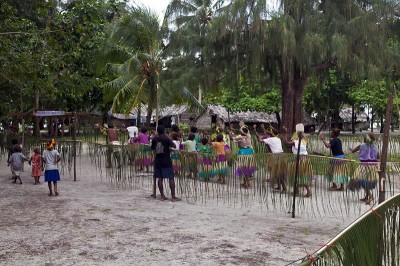
Mola’a villagers dancing through the maze of palm fronds.
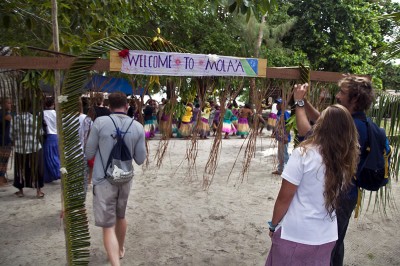
Scientists photographing the welcome sign.
Upon entering the village, we were all asked to line up behind a mark drawn in the sand. With big smiles on our faces, we watched the women’s coordinated dance while the bamboo band played another song behind them. The women were dressed in handmade grass skirts that were dyed with various colors and some of the women wore headdresses and arm bands made out of flowers and leaves.

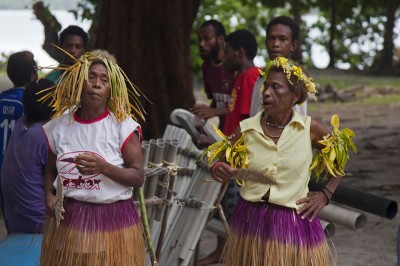
Women dancing to the bamboo band.
After the song was over, the women and children grabbed flower necklaces and headdresses. They got in a single file line and headed towards us. Each woman stood in front of us and placed the flower necklaces around our necks and headdresses on top of our heads. They then headed back to the other side with the other villagers. Then the rest of the village lined up to shake each of our hands and/or sniff us. In Mola’a it is considered a sign of respect to sniff another person either on the hand or near their face.
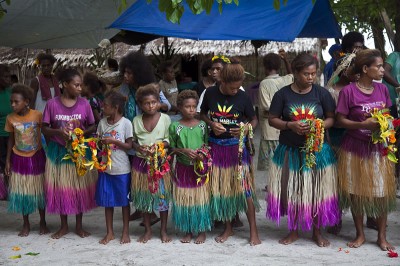
Women and children preparing to give us flower headdresses and necklaces.
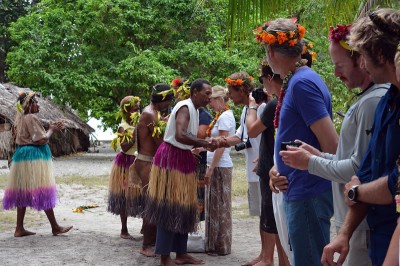
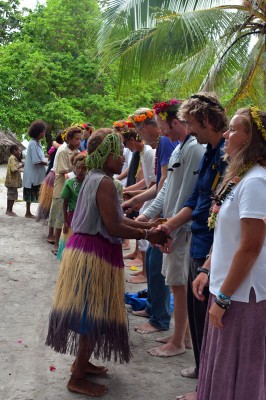
Villagers shaking hands with science and education teams.
Next, Elder Jafford gave a speech welcoming us into the village. He said, “We welcome you the Living Oceans Foundation team to Mola’a. We are happy to welcome you here and we feel very lucky that you have come from all around the world to come here to our village. It doesn’t matter where we come from or what color our skin is or what language we speak, we are all friends trying to protect our marine environment.”
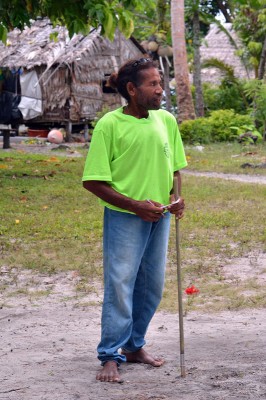
Elder Jafford giving welcome speech.
This traditional ceremony is a way to welcome guests into their village. It also signifies peace and that the visitors are now a part of the village.
Dr. Andrew Bruckner spoke on behalf of the Living Oceans Foundation thanking everyone in the village. Then each one of our team members introduced themselves explaining who they are, where they come from, and what they are doing on the trip.
Next, we were invited to enjoy the local cuisine, which included fresh papaya, watermelon, cooked breadfruit, dried banana, cooked cabbage, cassava roll, kumara (sweet potato) chips, and of course fresh coconut water, which we drank right from the coconut.
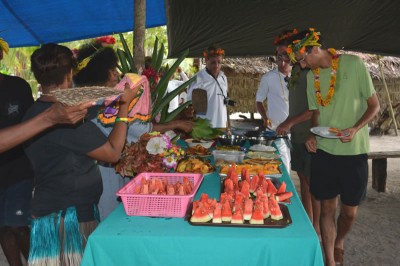
Scientists enjoying local cuisine.
After light refreshments, the music and dancing was revived and a couple of traditional dances were performed. Next, we were pulled into the circle to dance. Holding hands with our new friends, we danced round and round the circle laughing, smiling, and glad to be a part of such a special ceremony.
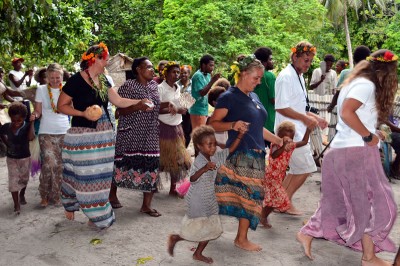
Team members enjoying our new friends from Mola’a.
When the music concluded everyone dispersed for a village tour. Many of us walked hand-in-hand with children from the village leading us around while others talked to the village adults or bought local handicrafts.
Before we knew it, the sun was starting to set and we had to leave this beautiful island community. The villagers walked us to the beach where we took photos with our new friends and said our goodbyes. From our boats, we waved goodbye to the villagers until we could barely see them standing on the beach.
In the following days, we talked about our experiences from the welcome ceremony on the island. This extraordinary experience will forever be engrained in our memories as will the people of Mola’a.
Photos: 1-6 and photo album Ken Marks; 7-12 Amy Heemsoth
Video: Stefan Andrews
Please see the photo album below for more photos.
